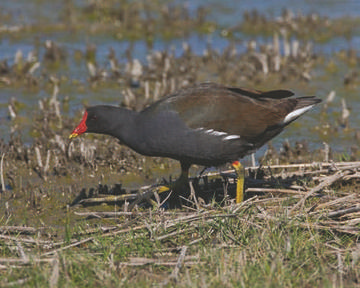
Moorhen © Richard Steel
British Moorhens are highly sedentary, but are joined in winter by migrants from continental Europe, especially the Netherlands, Germany and Denmark (Migration Atlas). A bird ringed at Woolston in February 2007 was found in Denmark in October 2007.
As expected for a sedentary species, there was little difference between the breeding and wintering distribution. They were recorded in both seasons in 547 tetrads, in 38 in winter only, and in 44 only in the breeding season, half of these in a relatively small area in the centre of the county: the apparent absence in winter in parts of SJ56 and SJ66 merits further investigation. Moorhens normally avoid the highest ground (BTO Winter Atlas) but, oddly, birds were found in four tetrads in the highest eastern hills where they did not breed. An interesting comment on its behaviour in one upland tetrad, near Oakgrove (SJ96J), where the species does breed, came from Steve and Gill Barber: ‘on a cold morning after a heavy frost we watched this bird as it grazed an area of short (sheep-grazed) grass high on a gorsey hillside’.
Moorhens eat a variety of plant and insect food, collected from in or near water, including seeds, fruit, pondweeds, worms, fish and carrion. More than one-third of records came from the smallest ponds, and in winter they stay on the small ponds but tend to retreat from other standing waterbodies, perhaps because of competition from flocks of waterfowl. The proportion on linear watercourses (G6 to G10) from 17% in the breeding season to 24% in winter, spread evenly across ditches, streams, rivers and canals. A century ago, Coward (1910) noted that ‘in winter, when the ponds are frozen, it resorts to running water’ and evidently some birds shift habitat even in the warmer climes of today. Moorhens quite frequently venture out of water, especially in damp grassy areas, and observers in 55 tetrads recorded them on agricultural grassland; they scamper back to the safety of water when alarmed, sometimes submerging with just the tip of the bill showing.
This bird is mostly a creature of freshwater, although a few gather on the Dee saltmarsh, 25 being flushed by high tide in winter 2006/ 07 at Gayton Sands (SJ27U). They seldom gather in large flocks and it is estimated that waters covered by WeBS counts hold only 1% of the British population (Brown & Grice 2005). In this Atlas, more than half of counts were of just one or two birds, and 90% of them were of ten birds or fewer. The largest flock was 71 at Gilroy Road Nature Reserve, West Kirby (SJ28I), counted by Chris Butterworth, double the next highest counts, 35 by Mary Prince and Susan Bastin on the Shropshire Union Canal at Christleton (SJ46M) and the same total by Alan Booth at Redes Mere (SJ87L).
Sponsored by Patrick King

